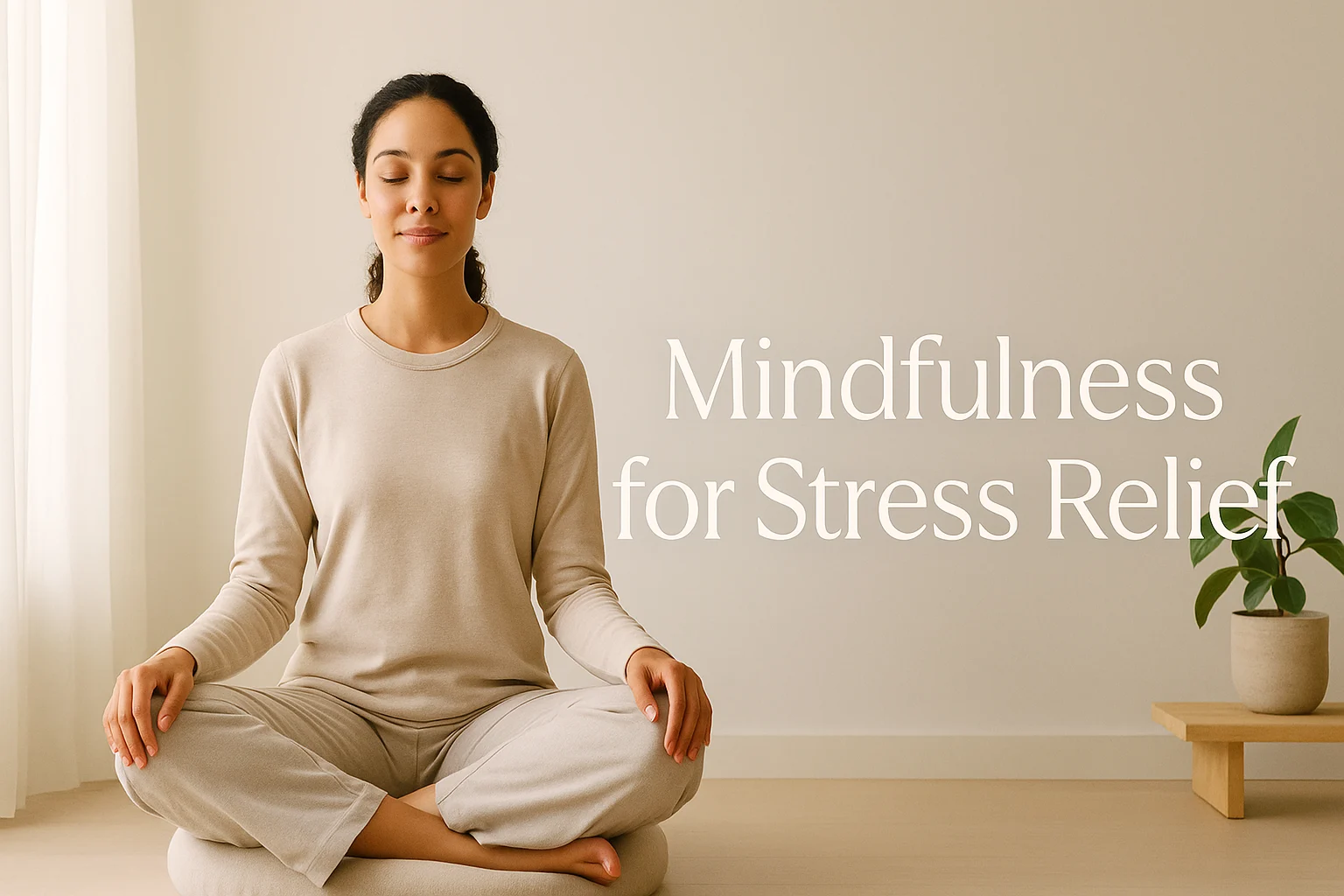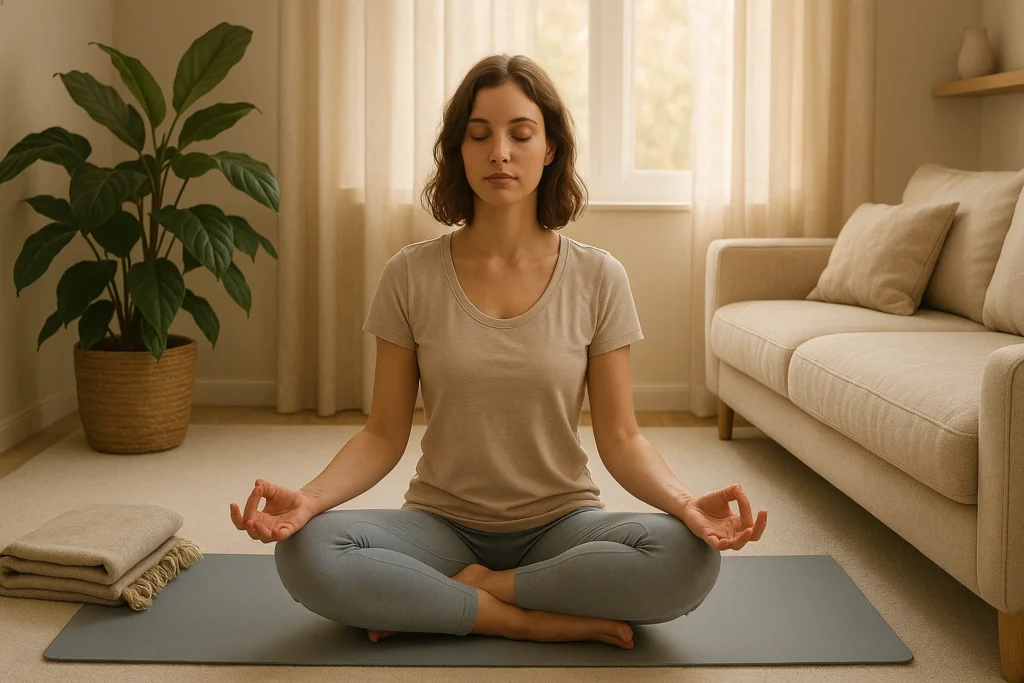
Feeling overwhelmed? 😥 From stacked deadlines to the family juggle, stress can hit like a wave. The good news: a few minutes a day can help you steady yourself. Meet Sarah, a busy mom who uses a 2-minute mindfulness stress relief reset during chaotic moments. For a deeper walkthrough, see our mindfulness techniques guide: mindfulness techniques for stress. This guide shares simple, research-informed ways to find steadiness—tools you can use anywhere. Let’s dive in. ✨
Find Your Calm Now!Table of Contents
Key Takeaways
- Mindfulness is about being present: Paying attention to this moment—without judgment—can help you find a bit more ease when stress shows up.
- It may support brain changes: Regular practice is associated with shifts in stress hormones and regions linked to focus and emotional regulation.
- Small steps, steady impact: Just a few minutes of mindful breathing, walking, or eating can help lower stress levels.
- Broad benefits: Beyond stress, mindfulness may improve sleep and focus, and can support managing anxiety and depression.
- Consistency matters: A short, daily routine makes mindfulness a powerful tool for life’s challenges.
- Mindful living tips: Small changes in how you eat, breathe, and move can create a calmer lifestyle.
Now, let’s explore what mindfulness really is and how it works to ease stress.
This post has affiliate links. We may earn a commission. Learn more.
What is Mindfulness Stress Relief?
Simply put, mindfulness is the practice of paying attention on purpose to the present moment, without judgment. 🤔 It’s about noticing what’s happening right now—your breath, the sounds around you, or the feel of your feet on the ground—without labeling it as good or bad. For more detailed strategies, check out this mindfulness techniques for stress guide.
Beginner-Friendly Mindfulness Stress Relief Practices
You don’t need to be a meditation expert to start mindfulness for stress relief. These simple practices fit into busy schedules and take just minutes.
Mindful Breathing: Your Stress Relief Anchor 🌬️
Your breath is always with you, making it a perfect tool for stress relief through mindfulness. Try this in a hectic moment, like before a big meeting.
- Find a comfortable position: Sit with feet flat or lie down.
- Close your eyes (or soften your gaze): Pick a spot to focus on if closing eyes feels odd.
- Notice your breath: Feel the air in your nostrils, chest, or belly. Is it deep or shallow?
- Observe without changing: Let your breath flow naturally.
- Redirect wandering thoughts: When your mind drifts (e.g., “I forgot to email Bob”), gently return to your breath.
- Start small: Try 1–2 minutes, then build up.
Pro Tip: Practice during your morning coffee break for instant calm.
Breathwork for Anxiety Relief 😮💨
For anxiety, specific breathwork can signal safety to your nervous system. Here are two techniques:
- 4-7-8 Breathing:
- Place your tongue behind your upper front teeth.
- Exhale completely with a “whoosh” sound.
- Inhale through your nose for 4 seconds.
- Hold for 7 seconds.
- Exhale through your mouth for 8 seconds.
- Repeat 4 times.
Why it helps: The long exhale may activate relaxation.
- Box Breathing:
- Exhale gently for 4.
- Hold for 4.
- Inhale through your nose for 4.
- Hold for 4.
- Repeat a few rounds.
Why it helps: That even rhythm signals “all clear” to your nervous system—a handy reset in high-pressure moments.
Mindful Eating: Savor Every Bite 🍎
Make a meal your practice by easing the pace. Try it at lunch and notice how satisfied you feel.
- Look: Notice color, shape, and texture.
- Touch: Feel the texture in your fingers before the first bite.
- Smell: Notice its aroma.
- Place in mouth: Feel it on your tongue before chewing.
- Chew slowly: Notice flavors and texture changes.
- Swallow: Feel it move down your throat.
- Notice aftertaste: Any lingering flavors?
This practice may reduce stress and enhance your connection to food. For a step-by-step approach, explore this mindfulness eating exercise guide.
Mindful Walking: Move with Presence 🚶♀️
Transform your daily stroll into stress-relieving mindfulness. Perfect for a lunch-break walk. For an in-depth guide, check out this mindfulness walking meditation.
- Find a quiet place: A park or hallway works.
- Notice your body: Feel your feet on the ground.
- Focus on steps: Feel your heel lift and roll.
- Sync with breath: Inhale for 3 steps, exhale for 3.
- Expand awareness: Notice sounds and air on your skin.
- Redirect thoughts: Gently return to walking sensations.
Mindful Listening: Tune into Sounds 👂
Sharpen your focus with this quick practice, great for a quiet moment at home.
- Sit comfortably and close your eyes.
- Take a few deep breaths.
- Notice obvious sounds (e.g., traffic).
- Listen for subtle sounds (e.g., your breath).
- Observe sounds without labeling them as good or bad.
- When your mind wanders, bring attention back to hearing.
This quick check-in helps ground you and pairs well with movement practices like mindful walking.
Mindful Journaling: Process Thoughts ✍️
Journaling helps you observe emotions—great for unwinding after work.
- Find a quiet space with a notebook.
- Set a timer for 5–10 minutes.
- Write freely, ignoring grammar.
- Use prompts like: “What am I feeling?” or “What’s in my body?”
- Notice thoughts come and go without getting pulled in.
Yoga: Mindful Movement for Stress Relief 🧘♀️
Yoga links movement with breath and may help you settle your system. A gentle class after work is a friendly place to start.
- Tension release: Unhurried stretches may ease built-up tension.
- Focus: Holding a few steady poses can help your attention feel steadier.
- Emotional balance: Practice may support a calmer, more self-compassionate mood.
Pro tip: Start with Hatha or Restorative if you want a softer entry.
Mindfulness for Workplace Stress
Swamped at work? Try a 2-minute desk reset: pause, take five slow breaths, notice the air in your nostrils, and feel your chair supporting you. It’s a quick way to settle before a meeting or a deadline.
Mindfulness Benefits: Science-Backed Insights
Mindfulness is supported by growing research and may offer a wide range of benefits. Below are the mindfulness benefits supported by current studies. Programs like Mindfulness-Based Stress Reduction (MBSR) have been associated with reductions in perceived stress and, in some studies, cortisol; results vary. For a clear overview, see this NIH overview. Here’s how practice may support your brain and body.
Reducing Stress Hormones
- Cortisol: Mindfulness practices may help lower cortisol for some people, which can support calmer mood and overall well-being.
- Blood Pressure: Breathing practices may help calm the “rest and digest” system.
- Sleep: Mindfulness may improve sleep quality by easing a busy mind.
Rewiring Your Brain for Resilience
- Amygdala: Some imaging studies suggest changes in threat-detection areas with regular practice.
- Prefrontal Cortex: Practice may support skills for attention and emotional regulation.
- Insula: Research notes differences in regions linked to body awareness; more study is needed.
- Connectivity: May support networks involved in attention and self-regulation.
Psychological Benefits for Stress Relief
Mindfulness offers mental health perks, too.
Improved Focus
- Less Mind-Wandering: Trains your attention to stay present.
- Better Attention Span: Can help concentration for tasks.
- Working Memory: May support working memory involved in learning.
For more strategies to sharpen your concentration, explore these mindfulness techniques for focus.
Recovery Support
- Managing Cravings: Helps observe urges without acting on them.
- Pain Management: May reduce suffering by changing your relationship with pain.
- Burnout: Self-compassion practices can support recovery.
Learn how mindfulness aids recovery in this mindfulness for recovery support guide.
Panic Attack Relief
- Grounding: Focus on senses to exit panic loops.
- Observing Sensations: May reduce fear of physical symptoms.
- Compassionate Awareness: Can soothe self-criticism during attacks.
For targeted strategies, check out this guide on mindfulness for panic attacks.
Depression Support
Mindfulness-Based Cognitive Therapy (MBCT) combines mindfulness with therapy and is used to help prevent depressive relapses for some people. Discover more in this mindful meditation for depression resource.
- Break Rumination: Helps detach from negative thought cycles.
- Emotional Regulation: Supports managing intense emotions.
- Self-Compassion: Fosters kindness toward yourself.
With these benefits, mindfulness can be a game-changer. Let’s learn how to make it a habit.
Building a Daily Mindfulness Routine
Consistency is key to stress relief through mindfulness and other stress reduction practices. Here’s how to make it stick.
Start Small
Begin with 2–5 minutes daily. Even 60 seconds of mindful breathing counts. Gradually increase as you feel benefits.
Pro tip: Treat it like brushing your teeth—same time each day, non-negotiable.
Anchor to Existing Habits
Pair mindfulness with daily routines:
- Morning: 5-minute breathing before coffee.
- Commute: Mindful listening on your walk.
- Meals: Savor the first few bites.
- Bedtime: Short body scan.
Schedule with Flexibility
Add mindfulness to your calendar as part of your stress reduction practices, but don’t stress if you miss a session. Just resume the next day.
Overcome Challenges
- “My mind wanders!” Totally normal—just bring it back.
- “No time!” One minute still counts.
- “It’s boring!” The payoff grows with practice.
- “I’m doing it wrong!” If you’re present, you’re doing it right.
Be Kind to Yourself
Treat yourself with patience, like a friend learning something new.
Mindful Living Tips: Use Guided Resources
Apps like Insight Timer or short YouTube guided meditations can keep you on track—pick one voice you like and stick with it for a week. These mindful living tips can keep you consistent without feeling rigid.
Mindfulness Routine Builder
Not sure where to start? This tool creates a personalized mindfulness routine based on your time and preferences. 😊
Mindfulness Routine Builder
Choose your available time and activity style to get a tailored mindfulness practice.
Activity Color Indicators:
60-Second Mindfulness Resets
Short on time? These one-minute resets fit into real life so you can steady your nervous system without a full session.
- Inbox pause: Before opening email, place one hand on your belly and take six slow breaths. Notice the rise and fall, then begin.
- Traffic light check-in: When stopped, feel both feet on the floor and locate three sounds around you. Green light = go, mind = calmer.
- Meeting micro-scan: Relax your jaw and forehead, drop your shoulders, and lengthen the exhale for five breaths.
- Parenting moment: Whisper “inhale, exhale” for 30 seconds before responding. You’ll speak from steadiness, not reactivity.
- Bedtime unwind: Count five slow breaths while tracing a gentle square in the air: up, across, down, across.
- Snack reset: Take one mindful bite—look, smell, chew slowly, and notice the flavor change. Let rushing fall away.
7-Day Starter Plan
Use this simple week to build momentum. If you miss a day, just pick up where you left off.
- Day 1: 2 minutes of mindful breathing on waking. Note one word that describes how you feel.
- Day 2: Box breathing (4-4-4-4) for 3 minutes before lunch. Jot a sentence about your energy.
- Day 3: Mindful eating for the first three bites of dinner. What flavors did you notice?
- Day 4: 5-minute mindful walk after work. Count ten steps with the breath: three in, three out, repeat.
- Day 5: Body-scan audio (5–10 minutes) before bed. Circle any areas that softened.
- Day 6: Loving-kindness for 5 minutes. Include yourself and one person you see often.
- Day 7: Choose your favorite practice and repeat it. Celebrate the win with a small ritual (tea, stretch, note).
Common Mistakes & Fixes
- Waiting for “perfect” time: There isn’t one. Use micro-resets while life is happening.
- Forcing calm: The goal is awareness, not a specific feeling. Let sensations be as they are.
- All or nothing: One minute counts. Consistency beats intensity.
- Holding the breath: Favor a longer, easy exhale. If dizzy, return to natural breathing.
- Judging yourself: Spot the judgment, call it “just a thought,” and return to your anchor (breath, sound, steps).
- Ignoring the body: Drop the shoulders, unclench the jaw, and soften the belly. Often the mind follows the body.
Track Your Progress
Light tracking keeps motivation up without turning practice into homework. Try a pocket notebook or notes app:
- After each session: Record duration, practice type, and one word for your mood.
- Weekly check-in: Scan sleep, focus, and reactivity. Look for tiny shifts, not perfection.
- Habit stacking: Anchor practice to an existing routine (coffee, commute, lunch, bedtime) for automaticity.
- Gentle course-correct: If you miss two days, do a 60-second reset to restart. Momentum matters more than streaks.
Ready to try these? Next, let’s explore the science behind how mindfulness eases stress.
Frequently Asked Questions
Conclusion
You’ve explored a complete guide to mindfulness-based stress relief techniques, from simple practices to research-informed benefits. Mindfulness doesn’t eliminate stress—it can help you meet it with more calm and clarity. Start small, perhaps with a 2-minute practice today, and build a routine that fits your life. Your path to steadier moments is one breath away. ✨ For next steps, keep our mindfulness techniques guide handy.


